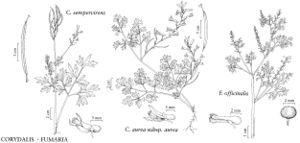Corydalis sempervirens
Syn. Pl. 2: 269. 1807.
Plants biennial, from somewhat succulent roots. Stems usually 1, erect, 0.5-8 dm, very glaucous. Leaves compound; blade with 3-4 orders of leaflets and lobes; ultimate lobes oblongelliptic, obtuse, apiculate. Inflorescences terminal, racemose or paniculate, 1-8-flowered on each axis; bracts inconspicuous, narrowly elliptic, 2-5 × 0.5-1 mm. Flowers erect; pedicel slender, 5-20 mm; sepals ovate, short-attenuate, to 3 mm; petals pink, tipped yellow; spurred petal 10-15 mm, spur blunt, 3-4 mm, crest absent, marginal wing relatively broad, revolute, unspurred outer petal 10-13 mm; inner petals 9-12 mm, blade broadly obovate, with high, angular keel, claw slender, 6-8 mm; nectariferous spur 1/3 length of petal spur, blunt; style ca. 4 mm; stigma triangular, with 4 papillae. Capsules erect, linear, straight, (25-) 30-35 (-50) mm. Seeds ca. 1 mm diam., minutely decorated. 2n = 16.
Phenology: Flowering early summer–early fall.
Habitat: Rock crevices, talus, forest clearings, open woods, and on burned or otherwise disturbed areas in shallow, often dry soil
Elevation: 10-1550 m
Distribution

Alta., B.C., Man., N.B., Nfld., N.W.T., N.S., Ont., P.E.I., Que., Sask., Yukon, Alaska, Conn., Ga., Ill., Ind., Ky., Maine, Md., Mass., Mich., Minn., Mont., N.H., N.J., N.Y., N.C., Ohio, Pa., R.I., S.C., Tenn., Vt., Va., W.Va., Wis.
Discussion
The Iroquois used a decoction prepared from plants of Corydalis sempervirens medicinally to alleviate piles (D. E. Moerman 1986).
Selected References
None.
